- Home
- Hummingbird Paintings
- Hummer Types
What Types of Hummingbirds Do We See in the United States?
Photos, information and identification tips of the common types of hummingbirds in the United States.
Most hummingbird types visit here during the summer months and then fly south for the winter. Some Anna's and Allen's Hummingbirds live all year on the west coast.
The well-known Ruby-throated Hummingbird lives all parts of the eastern United States during the warm months. They fly south to Mexico and Central America for the winter.
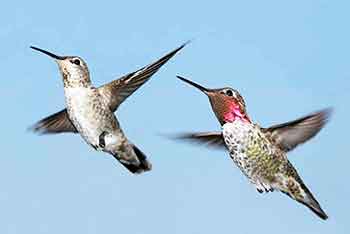 Pair of Ruby-throated Hummingbirds
Pair of Ruby-throated Hummingbirds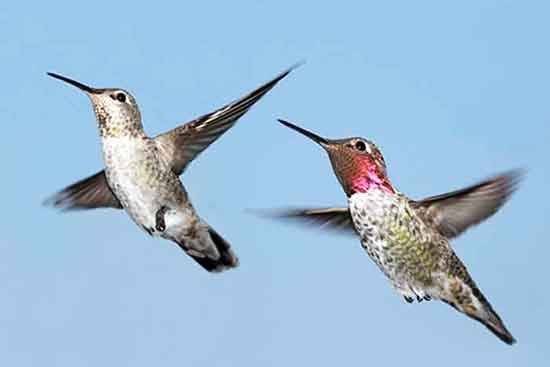 Pair of Ruby-throated Hummingbirds
Pair of Ruby-throated HummingbirdsRuby-throated Hummingbird
The Ruby-throated Hummingbirds are the most widespread hummingbird seen in the United States. They are common from east Texas to Florida and up the eastern states into south Canada.
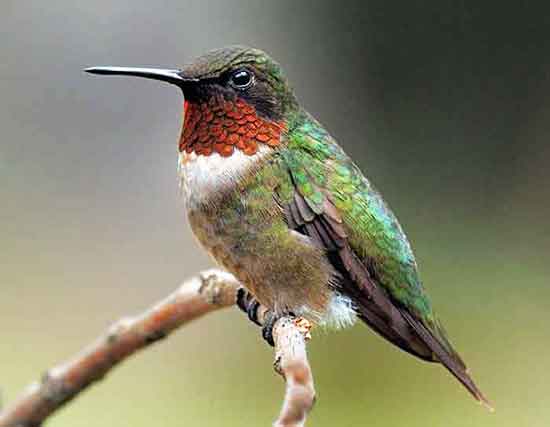 Ruby-throated Hummingbird, male
Ruby-throated Hummingbird, maleThe Ruby-throat gets its name from the male's ruby-red gorget, his throat.
The male is pictured above. In the sunlight his throat glistens a gorgeous red. Without direct sunlight, his throat will look almost black.
The top of his head, sides and back
also have iridescent feathers that glisten green in the sunlight. Out of the sun his colors look dark.
His primary wing feathers and tail are dark. There is a notch in the center of his tail. The beak and legs are dark.
Just below his ruby throat, the top part of his chest is white before a light-colored belly. In front of the tail, there are small white feathers on his bottom.
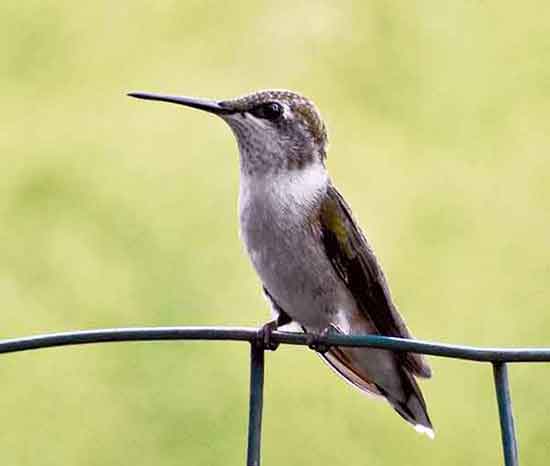 Ruby-throated female hummingbird
Ruby-throated female hummingbirdThe female Ruby throated Hummingbird has a whitish throat and chest. Sometimes there are fine speckles on her throat. Her head and back are iridescent green like the male Ruby-throat.
The female's tail, large wing feathers, beak and legs are also
dark.
The tips
of her tail feathers are white on the outside corners, but it is not notched.
Juvenile Ruby-throated Hummingbird males look very similar to the females.
But before they grow their entire set of feathers, you can see their white fuzzy bottoms, identifying them as youngsters.
Where Do the Ruby-throats Nest?
The female Ruby-throated Hummingbird will look for a
horizontal branch about 10' to 40' off the ground. Often the nest will be
over water to help them stay cooler.
She spends 6 to 10 days building a
nest. The nest will roughly be the size of a ping pong ball. The male does not
help with any nest building or baby care.
She builds the nest using small leaves, grass, fur, moss, lichens and spider webs. The spider webs enable the nest to stretch larger as the babies grow.
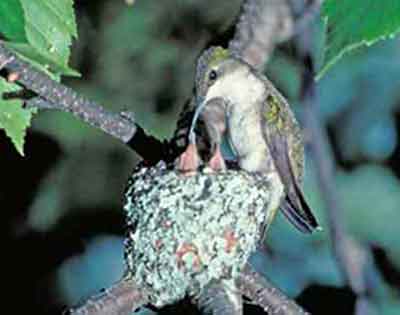 Ruby-throat feeding babies in the nest.
Ruby-throat feeding babies in the nest.When the nest is complete, she will lay 2 eggs a 1/2" in size. The eggs will hatch in 12 to 14 days.
The tiny birds are naked and blind when they hatch. They are no larger than a penny. Mom feeds them regurgitated insects and spiders mixed with nectar.
They grow fast and after three weeks they will start exercising their wings on the side of the nest.
After they leave the nest mom will continue to feed them for a few days until they are able to find food on their own.
They Head South for the Winter
In the fall, August to September depending on exactly where they live, the adults head south for the winter.
The males are the first to make the long trip. The adult females leave later.
The juveniles hang back and eat and then head south weeks after the older hummingbirds have already left.
- It's very important to keep our feeders up late in the fall to feed the migrating Ruby-throats. Keep their feeders up at least until the end of September.
- Then in the spring March to April,
they all fly back to the same area they left in the fall. They remember where
the feeders and flowers were from last year.
- These tiny birds, just over 3 inches big, fly 500-600 miles south to Mexico or Central America for the winter. Their flight across the Caribbean takes from 18 to 22 hours.
The next spring, they fly the long way back to the area where they were hatched. They return to the same area and sometimes to the same nest and feeders, they used the year before.
14 More Types of Hummingbirds
Hummingbirds are the most amazing little birds. They bless us by
coming to our flowers and feeders. We enjoy their beautiful colors and
flying antics.
Allen's Hummingbird
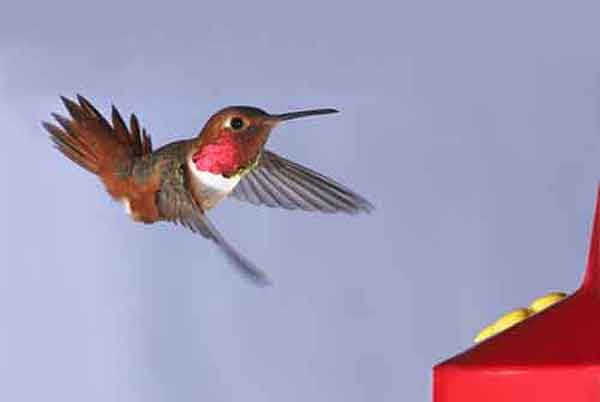 Allen's Hummingbird
Allen's HummingbirdAllen's Hummingbird is one of the types of hummingbirds that are full-time residents in the United States. It lives all year in California. It frequents the coastal foothills.
They look very similar to the Rufous Hummingbird. But the Rufous has a rust colored back and the Allen's has a metallic green back and head.
It has rufous colored sides and a copper-red throat on the male. It has a dark forked tail.
Anna's Hummingbird
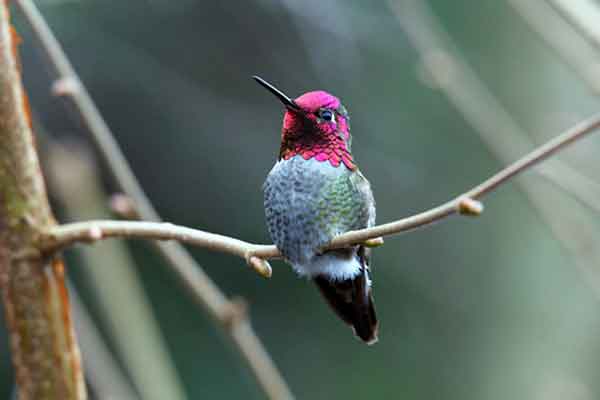 Anna’s Hummingbird
Anna’s HummingbirdMale Anna’s Hummingbirds have a flared rose colored gorget, and the same color on his head. This coloring distinguishes it from the Ruby-throated which has only a red colored gorget with a green head.
It is slightly larger than the Ruby-throat and has a bulkier looking body.
The Anna's Hummingbird is a full-time resident in the United States. It is found on the west coast of the United States from Canada to Mexico. In the winter it may range across the southern edge of Arizona to west Texas.
It lives in the lowland gardens and the mountains in the summer. In the winter it moves to the deserts. It often nests in Oak Trees.
Anna’s is one of the types of
hummingbirds that like a perch on their feeders, so they can sit to eat.
Black-chinned Hummingbird
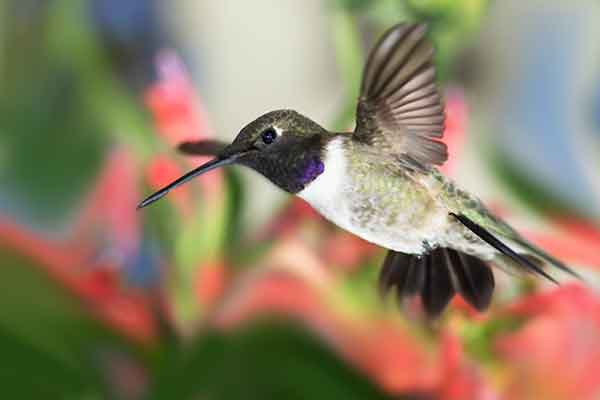 Black-chinned Hummingbird
Black-chinned HummingbirdBlack-chinned Hummingbirds are the western counterpart of the Ruby-throated Hummingbird.
These two types of hummingbirds are similar in appearance except instead of a ruby-throat the males have a black chin and their throat is a beautiful violet.
Their tail is notched and their bill is slightly down curved. The top of their head, back and sides are greenish.
The females also have greenish backs and heads with white chins and under parts. They may have fine specks on their throat. Other than her down curved bill she looks very much like a female Ruby-throat. Her wings are a little bit longer.
They reside from western Montana and Texas to California, including New Mexico and Arizona.
The female builds her nest by herself in trees or large shrubs often in the fork of small limbs. The nest is only about 1 ½” in diameter. She lays 2 eggs that hatch in about 16 days.
When the babies have feathers the mother will often build another nest within sight of the first nest to raise a second set of babies.
What
a hard worker, she does it all by herself. But, it is great for keeping the
species going.
Blue-throated Hummingbird
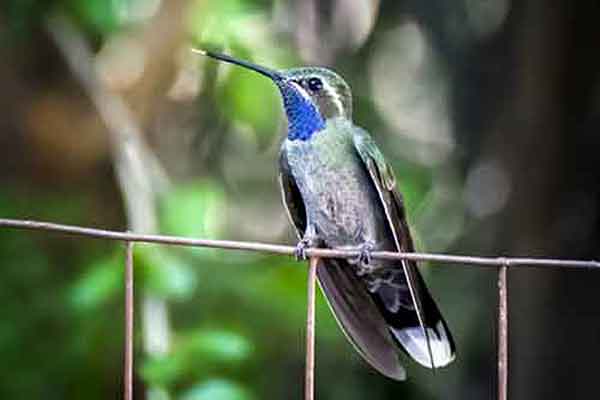 Blue-throated Hummingbird
Blue-throated HummingbirdBlue-throated Hummingbirds are one of the largest type of hummingbirds in the United States. It is around 5 inches, much larger than most of our other types of hummingbirds.
Our other hummingbird types are in the 3 to 4 inch range.
Bother male and female have two white stripes on their face. It has one eyebrow stripe above the eye. And a smaller, whisker white stripe below the eye.
It has a large blackish colored tail with white corner. The male has a blue throat. Its belly is grey.
It
is seen in Arizona, New Mexico, Texas and sometimes Colorado.
Broad-billed Hummingbird
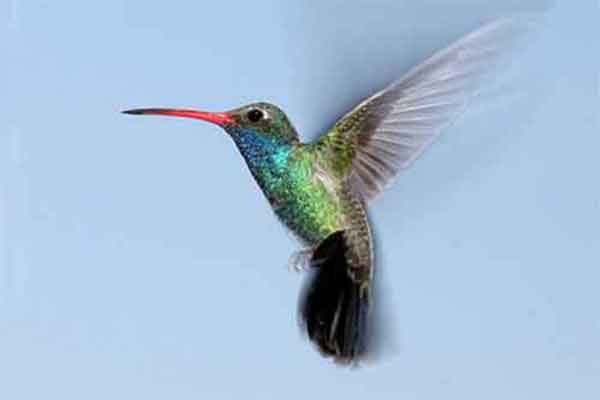 Broad-billed Hummingbird
Broad-billed Hummingbird
Broad-billed Hummingbirds are seen in Arizona, New Mexico, western Texas, and Mexico.
You can paint this hummingbird with a step-by-step tutorial.
The Broad-bill is one of the types of hummingbirds that come into the United States through Mexico.
Many hummers have dark bills, but the Broad-bill has a red bill with a dark tip.
The male has a dark metallic green body, but in poor light it will look black. His throat is a beautiful blue.
The
female is green above with light gray under parts.
Broad-tailed Hummingbird
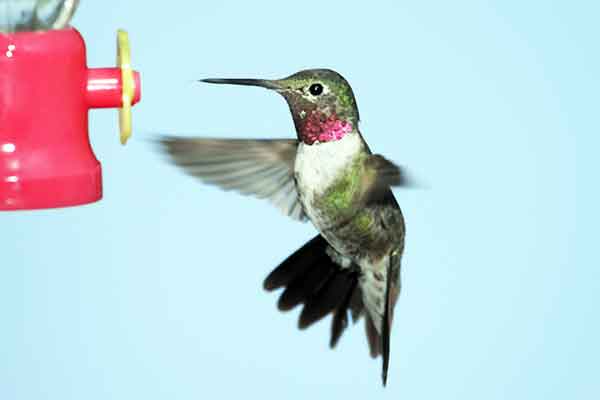 Broad-tailed Hummingbird
Broad-tailed HummingbirdBroad-tailed Hummingbirds breed in the United States from California to Wyoming and south to Arizona, New Mexico and Texas.
It is frequently seen in the Rocky Mountains and it nests at high altitudes. Some stay the year round in southern Arizona, Texas and some areas of the Gulf Coast.
It looks very similar to the Ruby-throated Hummingbird, but they live in different parts of the country, so there is no confusion.
Its crown and back are a dark green. Its sides are greenish. Its broad tail is also greenish. The male has a rose-red throat.
The female has cinnamon on her sides and some spots on her throat.
The male's wings make a loud
trilling sound when he is flying; this sound is not heard in other types of
hummingbirds.
Buff-bellied Hummingbird
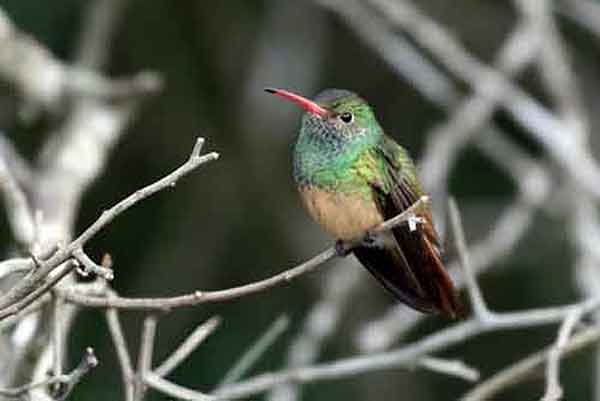 Buff-bellied Hummingbird
Buff-bellied HummingbirdBuff-bellied Hummingbirds are seen fairly often in south Texas. It commonalty nests in south Texas. A few stay the winter in Texas.
Its head, back and upper chest is green. Its belly for which it was named is buff colored.
They have a red bill that is black on the end. It has a rufous colored, forked tail.
The male and females look similar.
How many types of hummingbirds are there?
Calliope Hummingbird
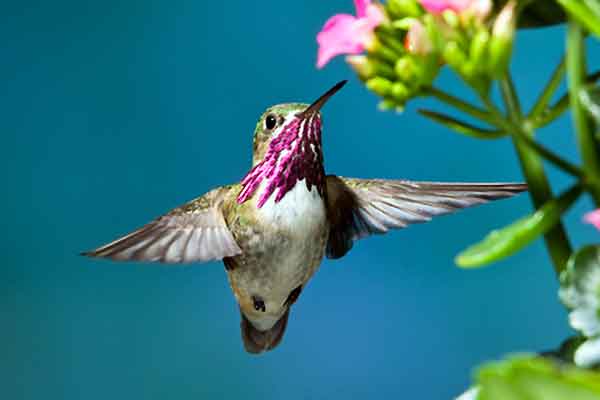 Calliope Hummingbird
Calliope HummingbirdCalliope Hummingbirds are seen in sub-alpine forests, especially near streams of southern Alberta and British Columbia.
They are fairly numerous in British Columbia through Montana, Idaho, Washington, Wyoming, Nevada or eastern California.
They however are not seen in the coastal areas, except sometimes on the coast of western Texas, Arizona, and New Mexico.
They have a shorter bill than some other types of hummingbirds.
They
have long reddish purple feathers on their gorget which they are able to flare
out. Their white neck shows in between the long gorget feather.
Costa's Hummingbird
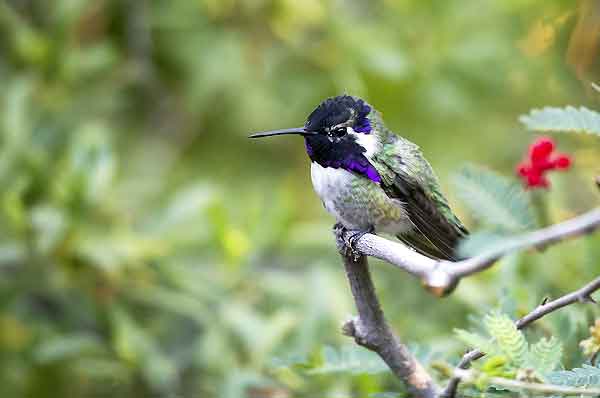 Costa's Hummingbird
Costa's HummingbirdThe Costa's Hummingbird has similar coloring to the violet throat of the Black-chinned.
However the blue-violet gorget of the Costa is flared and his head is the same violet color.
This type of hummingbird is found in desert areas of Nevada, Arizona, and California.
They
prefer the dry desert areas and build their nests far from water. They
often build their nests in cacti and yuccas.
Green Violet-ear Hummingbird
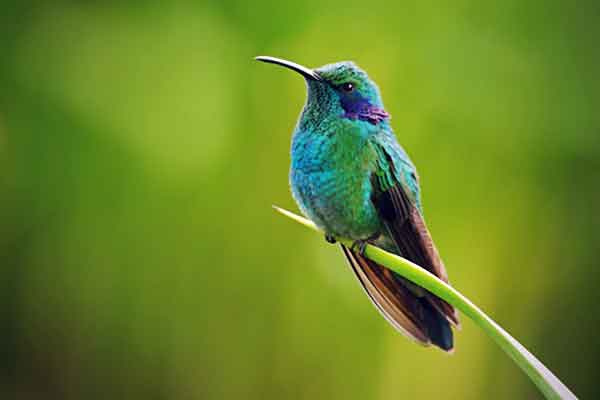 Green Violet-ear Hummingbird
Green Violet-ear HummingbirdThe Green Violet-ear Hummingbird is one of the types of hummingbirds that is seen less frequently in the United States. It visits Texas and it has been seen in Alabama.
Both male and females look similar. Their entire bodies are a beautiful iridescent green, God's gifts of flying jewels.
It has a purple-blue patch by its ear and a similar colored patch in the center of its chest.
It
has a bluish-green tail. Their bill is slightly down-curved.
It
is known to be aggressive and chases other hummingbirds.
Magnificent Hummingbird
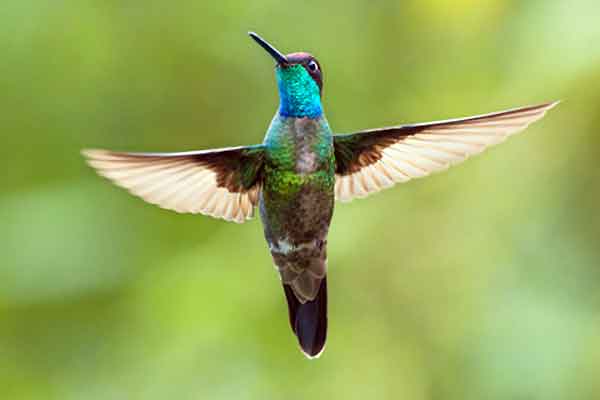 Magnificent Hummingbird
Magnificent HummingbirdMagnificent Hummingbirds, along with the Blue-throated Hummingbird are the largest types of hummingbirds in the United States.
The Magnificent can get up to 5.35 inches. The Blue-throated can get up to 5.20 inches.
They both have blue throats. However the Magnificent's throat is more blue-green. Its crown is purple and mostly dark looking.
The female has grayish underparts.
Male and female both have a bright white stripe behind their eye, a long bill and a long tail.
They
are seen fairly regularly in Arizona, New Mexico and Texas. They breed in these
areas. A few have been seen in Utah and Nevada at higher elevations. Some
overwinter in Arizona.
Rufous Hummingbird
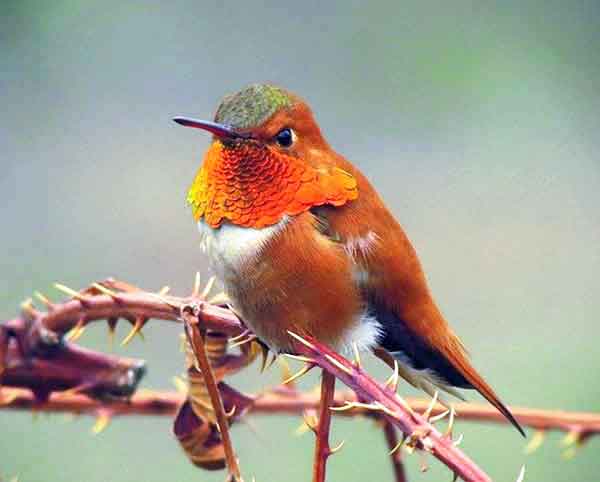 Identify the amazing hummingbirds
Image
Identify the amazing hummingbirds
Image Rufous Hummingbirds true to their name are rufous (a rusty orange color). The male has a bright orange-red gorget. His back, tail and sides are rufous color. They may have some green flecks on their head and back.
The female has rusty color on her sides and under her tail. She has small red to green-gold spots on her throat.
The Rufous Hummingbird is easy to identify because their rusty, rufous color is lacking in most other types of hummingbirds.
You can hear them talking with a loud chirp and chatter when they come to your feeder. They are one of the noisy types of hummingbirds.
They are fairly numerous from Alaska to Mexico and in between. They live from the mountains to the lowlands. Some may winter on the gulf coast. A few have been sighted farther east late in the season.
Hummingbird
migration facts are amazing; Rufous migrate up to 2,000 miles.
Violet-crowned Hummingbird
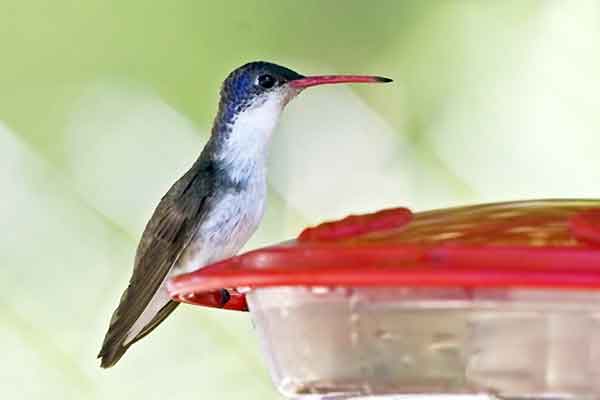 Violet-crowned Hummingbird
Violet-crowned HummingbirdViolet-crowned Hummingbirds visit and breed in Arizona and New Mexico. They favor sycamore trees and canyons at low to middle elevations. They often nest near water.
A few have been seen in Southern California. And some have overwintered in Arizona.
The male and females look very similar. They have a red bill with a black tip.
They
have a striking white throat and a light colored belly. The top of their head
is a violet-blue.
White-eared Hummingbird
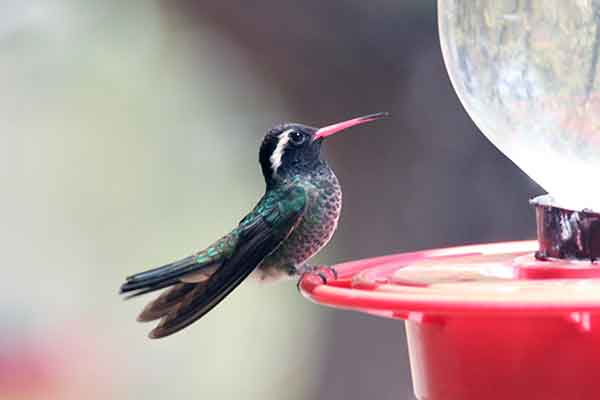 White-eared Hummingbird
White-eared HummingbirdWhite-eared Hummingbirds are a less frequent visitor to the United States.
It lives in Mexico and South America, but sometimes comes to southern Arizona and New Mexico and is seen breeding and nesting there. It is rarely seen in west Texas.
Their red bill has a black tip.
Both male and female have a white stripe behind the eye.
The
male has purplish on its head and chin and a green gorget. The female has
greenish spots on her throat.
How Long Do Hummingbirds Live?
Many hummingbirds live on the average of four to five years. The Ruby throated Hummingbirds may live from seven to nine years, maybe ten.
They come back to the same place each year, mostly to the area where they hatched. They remember where they found their favorite flowers and feeders the year before.
We had a female Ruby-throat in Florida. She would tell me if I didn't have the feeder up in the spring. She would fly around looking in all the window near where her feeder was hanging the year before.
Invite the hummingbirds to Your Garden
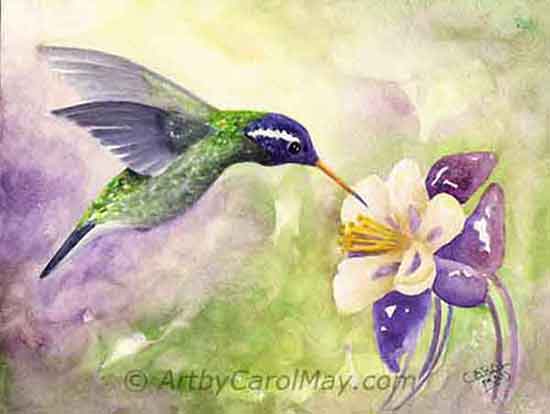 A White-eared visiting a Columbine flower.
A White-eared visiting a Columbine flower.Flowers for the hummingbirds will bring the hungry hummers to your garden.
Hummingbirds are attracted by red colors. Start out by planting some red flowers to attract them.
But they will feed from any flower color where there is nectar.
They have been seen feeding from orange, pink, purple, lavender, yellow, white and even blue flowers.
They favor trumpet-shaped flowers because they contain more nectar.
Feeders Are Great for Attracting Hummingbirds
When we don't have flowers, it's fun to put out feeders for the hummingbirds.
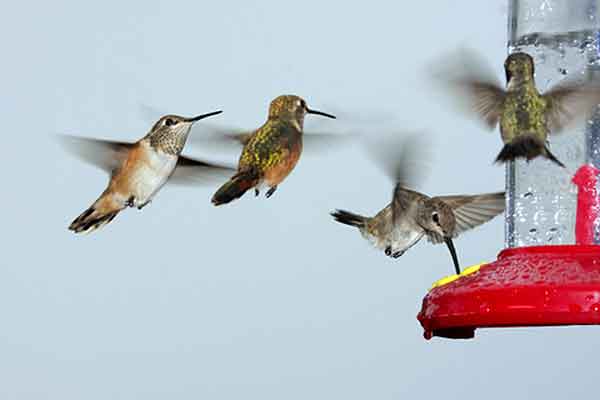 Don't put red coloring into their food.
Don't put red coloring into their food.Hummingbird Food Recipe
- Four boiling cups water + one cup white sugar
- Do not use brown sugar.
The sugar content of the hummingbird’s favorite flowers is approximately 25%. So that gives us the perfect proportions for feeding hummingbirds.
Keep the feeders clean and full.
It's best to hang the feeders in the shade, if possible.
When Do We Feed Hummingbirds.
- Put the feeders up in the spring. It's usually April in most areas, farther north it may be a bit later.
- Keep the feeders up late, so the migrating hummingbirds will be able to find food on their trip south.
- Don't stop feeding until we have not seen one hummingbird for at least 2 weeks.
- This normally is by the end of September. In Florida, they may still be around the first part of October.
You are sure to see at least one of these types of hummingbirds where you live.
Plant flowers or put out feeders for
the hungry hummers. You will have these beautiful little gifts from God coming to your
yard!















 Are you eager to learn how to oil paint? What are the essential supplies for oil painting? What do we need for clean-up and how long do oil paintings take to dry? Learn the rules of oil painting and t…
Are you eager to learn how to oil paint? What are the essential supplies for oil painting? What do we need for clean-up and how long do oil paintings take to dry? Learn the rules of oil painting and t… How do we create a focal point in art? Where do we put the focal point? How do we find the focus of an artwork? Should all paintings have a center of interest or can they have more than one? Learn fro…
How do we create a focal point in art? Where do we put the focal point? How do we find the focus of an artwork? Should all paintings have a center of interest or can they have more than one? Learn fro… Art elements and principles appear over and over in good paintings. The elements and principles work together for us to create successful artwork. Art principles are the rules that govern how an artis…
Art elements and principles appear over and over in good paintings. The elements and principles work together for us to create successful artwork. Art principles are the rules that govern how an artis…